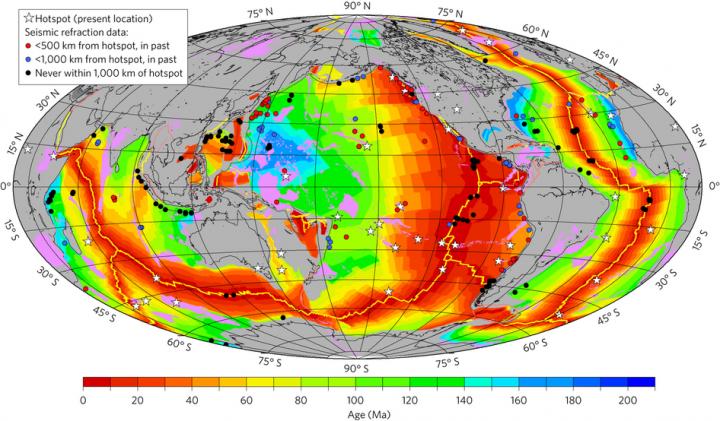Breakup of supercontinent Pangea cooled mantle and thinned crust

Researchers at the University of Texas Institute for Geophysics used the location of seismic refraction data (circles) and mantle hotspots (white stars) to examine whether mid-plate volcanism substantially influenced the thickness of aged ocean crust. The modern mid-ocean ridge system is marked by a yellow line. Areas in violet outline large igneous provinces. Credit: The University of Texas at Austin Jackson School of Geosciences
The thinning is related to the cooling of Earth's interior prompted by the splitting of the supercontinent Pangaea, which broke up into the continents that we have today, said Harm Van Avendonk, the lead author of the study and a senior research scientist at The University of Texas Institute for Geophysics. The findings, published in Nature Geosciences on Dec. 12, shed light on how plate tectonics has influenced the cooling of the Earth's mantle throughout geologic history.
“What we think is happening is that the supercontinent was like an insulating blanket,” Van Avendonk said. “So when these continents started opening up and the deeper mantle was exposed, more or less, to the atmosphere and the ocean it started cooling much faster.”
All authors are from the University of Texas Institute for Geophysics (UTIG), a research unit of the Jackson School of Geosciences.
The mantle is the very hot, but mostly solid, layer of rock between the Earth's crust and core. Magma from the mantle forms oceanic crust when it rises from the mantle to the surface at spreading centers and cools into the rock that forms the very bottom of the seafloor. Since about 2.5 billion years ago, the mantle has been cooling –a phenomenon that doesn't influence the climate on the surface of the Earth and has nothing to do with the issue of short-term man-made climate change.
This study suggests that since the breakup of Pangea, the cooling rate of the mantle has increased from 6-11 degrees Celsius per 100 million years to 15-20 degrees per 100 million years. Since cooler mantle temperatures generally produce less magma, it's a trend that's making modern day ocean crust thinner.
“It's important to note the Earth seems to be cooling a lot faster now than it has been over its lifetime,” Van Avendonk said. “The current state of the Earth, where we have a lot of plate tectonic events, this allows the Earth to cool much more efficiently than it did in the past.”
The research that led to the connection between the splitting of the supercontinent and crust thickness started when Van Avendock and Ph.D. student Jennifer Harding, a study co-author, noticed an unexpected trend when studying existing data from young and old seafloor. They analyzed 234 measurements of crustal thickness from around the world and found that, on a global scale, the oldest ocean crust examined–170 million year old rock created in the Jurassic–is about one mile thicker than the crust that's being produced today.
“It's something that Jenny and I found, more or less, by accident,” Van Avendonk said.
The link between crust thickness and age prompted two possible explanations–both related to the fact that hotter mantle tends to make more magma: Mantle hot spots–highly volcanic regions, such as the Hawaiian Islands and Iceland–could have thickened the old crust by covering it in layers of lava at a later time. Or, the mantle was hotter in the Jurassic than it is now.
Van Avendonk mentioned this problem during a casual conversation with Joshua “Bud” Davis, a Ph.D. student in UTIG's plate tectonics research group and co-author, who said that the group could investigate both of the explanations using computer models of plate movement since the Jurassic and a global database of hotspots.
The analysis ruled out the hot spot theory–thick layers of old crust formed just as easily at distances greater than 600 miles from hotspots, a distance that the researchers judged was outside the influence of the hotspots. In contrast, the analysis supported the hypothesis of mantle heating during the age of Pangea, and mantle cooling after the breakup of the supercontinent.
The finding that splitting up Pangea cooled the mantle is important because it gives a more nuanced view of the mantle temperature that influences tectonics on Earth, Van Avendonk said. The researchers also note that the study illustrates the success that can come from spontaneous collaboration and leveraging basic research on a global scale.
“A cool part of this study is that it didn't need funding,” Harding said. “We went through all the literature, and collected all the data ourselves. There's always more information out there.”
Media Contact
All latest news from the category: Earth Sciences
Earth Sciences (also referred to as Geosciences), which deals with basic issues surrounding our planet, plays a vital role in the area of energy and raw materials supply.
Earth Sciences comprises subjects such as geology, geography, geological informatics, paleontology, mineralogy, petrography, crystallography, geophysics, geodesy, glaciology, cartography, photogrammetry, meteorology and seismology, early-warning systems, earthquake research and polar research.
Newest articles

Pinpointing hydrogen isotopes in titanium hydride nanofilms
Although it is the smallest and lightest atom, hydrogen can have a big impact by infiltrating other materials and affecting their properties, such as superconductivity and metal-insulator-transitions. Now, researchers from…

A new way of entangling light and sound
For a wide variety of emerging quantum technologies, such as secure quantum communications and quantum computing, quantum entanglement is a prerequisite. Scientists at the Max-Planck-Institute for the Science of Light…

Telescope for NASA’s Roman Mission complete, delivered to Goddard
NASA’s Nancy Grace Roman Space Telescope is one giant step closer to unlocking the mysteries of the universe. The mission has now received its final major delivery: the Optical Telescope…



